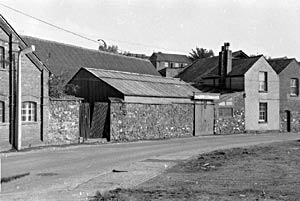
Exeter Stories
Exeter folk and friends in their own words - 1890's to the 1990's │ << Previous story │ Next story >> │
Cyril Brown`s reminiscences of Shilhay and the West Quarter
I started in 1918, in my father`s business, having been granted special leave from school as my father was single-handed at his workshop, with his other four sons in the forces. We were then making chain harness and other fittings for horse-drawn field artillery guns. My early days were of the horse and wagon and water wheel power in the mills. There were nine water wheels on the two leats which we used to overhaul and repair. In those days you had to be a smith, engineer, and carpenter as many of the mill wheels had wooden cogs to make them run silently, all having to be made and fitted by hand on site.
Cyril Brown remembered this little incident at Huxham & Brown
This firm specialised in tannery processing machinery, which was sent all over the world. The owner, Mr Brown, who lived in Larkbeare, was on his way home on a very foggy night when he mistook the lane of Shears Mill for Commercial Road and fell into the leat which at that time was unguarded. He was found drowned at the Baryta Mill next day.
Water for power and drinking
Water is probably the most important feature of the area. In addition to powering the Brewery, the grist and flour mills and the Baryta Works, it was used extensively in the processes themselves - from the complexities of the tannery to the initial inflating and cleansing of the sausage skins at Oppenheimers.
It was dipped up within living memory from the leats for household purposes, and until the last century from the river near Horsepool Bridge to load onto the water sellers carts.
The river provided for leisure as well as for trade. Mr Gregory`s landing stage was next to the old Exe Bridge and Mr C Ross`s private stage lay adjacent, with his guests suitably attired for a trip, embarking there for an excursion to the Double Locks in "Otranto".
Up the hill, however, water was a valuable commodity and had to be fetched to most private households. On a Saturday morning the turncock would open the granite conduit at the bottom of Lower Market so that the water would flow down the cobbled streets towards West Street, the housewives calling to one another "water`s on" as they ran out to stop the drains with cushions and brush down their yards in haste.
The Shilhay Hurricane
We heard this roaring, rushing sound almost like thunder. I was just going to run out and have a look when dad said "Come in, come in boy, don`t go out there". All of a sudden this stuff started coming down, corrugated iron sheets like confetti. Dad said "get under the bench, boy, get under the bench" and as he said it a piece of timber came right through the roof down through the workshop - it must have been one of the posts from Gabriels timber Yard, 8 inches square and 30 feet long. This noise went on for three or four minutes. When the dust cleared Dad went outside and said "I think the gasworks has blown up, the road is littered with corrugated iron". Then he said “The only place where there are any of those curved sheets round here is on Gabriel`s Belfast roof” and he thought a boiler had blown up there. After a few minutes the fire brigade and other services came and then we found it was this hurricane that had sort of spun round, lifted one of the roofs off the malthouse and the roofs off several of the drying sheds of Gabriels and taken them right up into the air where they disintegrated and came showering down in pieces. It was quite a freak and did not happen again. (editor - this story matches with a hurricane event in January 1934)
© 2007 Exeter Industrial Archaeology Group/David Cornforth
Cyril Brown was interviewed by the Exeter Industrial Archaeology Group in November 1975, during their project to document the area before the new housing was constructed. He worked for the family firm of W Brown and Son, opposite Bodley Bros in Commercial Road. This page is a number of selected extracts from these interviews.
W BROWN & SON Engineers (since 1929 area became Council Yard) : General Engineers, Millwrights and Smiths. In general demand locally, work obtained by private negotiations - no tendering, almost entirely in Commercial Road and Exe Island area. Repair work in Tremletts, mills and sawmills. Eight men employed.
 The foundry building of W Brown and Son in Commercial Road. Photo Alan H Mazonowicz
The foundry building of W Brown and Son in Commercial Road. Photo Alan H Mazonowicz
│ Top of Page │